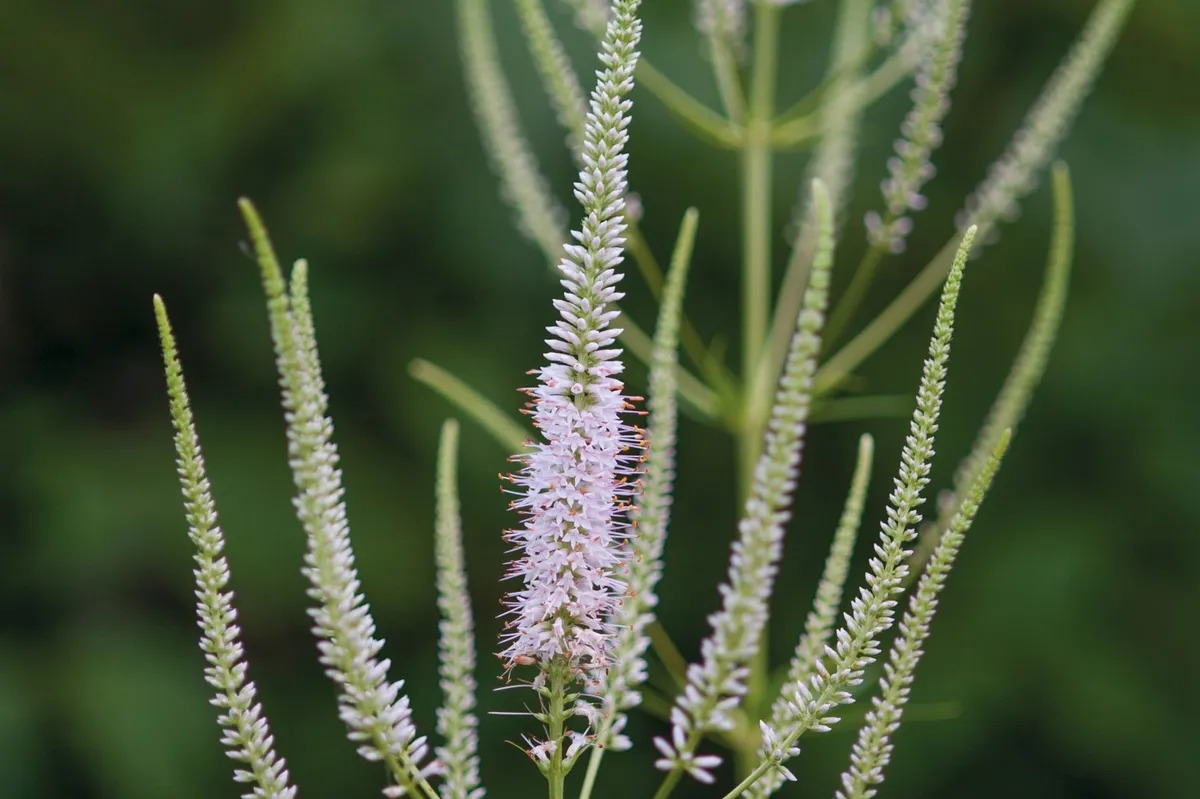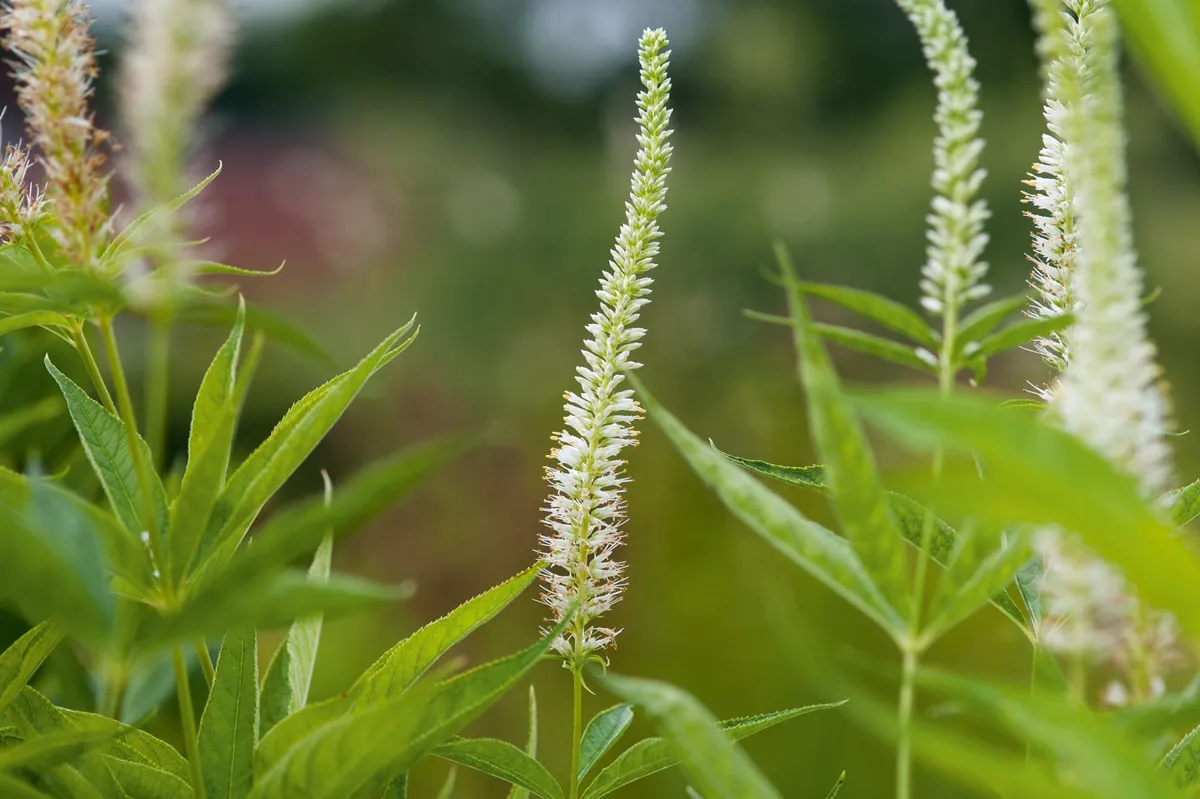What are veronicastrums?
Veronicastrums are hardy herbaceous perennials that supply strong vertical accents in the garden. Their common names include culver’s root, Bowman’s toot, black root and whorlywort. They have their origins in Eastern North America, East Asia, Japan, Korea, China, Siberia and Sakhalin Island. Their flowering season is from June to September, with structural interest through autumn and winter. Veronicastrums can grow to 1-1.8m and will tolerate most soils and a wide range of pH in sun or partial shade but not too dry. Most have a RHS hardiness rating of H7 (hardy to temperatures of -20C) and are suitable for gardens in USDA 3a-8b.
Don't miss our piece on the best perennials for more inspiration.
How to grow veronicastrums
Where to grow veronicastrums
As you’d expect from plants that hail from North America and Siberia, veronicastrums are able to survive most cold winters. In the wild, they’re found in a wide range of conditions from woodland, meadows, river banks and thickets, and can tolerate most soils although they grow best in sandy or loamy ground with sufficient moisture in sun or part shade.
In dry seasons some wilting may occur on free-draining chalk or sandy soils but generally veronicastrums need little attention after planting. On rich, moist soils they can grow to 2m or more with 60-75cm spread. Along with foxgloves and toadflax, veronicastrums are part of the Plantaginaceae family, which are all prone to fasciation. You can remove fasciated flower spikes by pinching out the tip of the plants in mid-May to develop side shoots that have not been affected. It does mean foregoing the first vertical veronicastrum flower spike but there will be a profusion of subsidiary ones, although the overall height will be reduced. Judicious manipulation of plants during their growth cycle can increase flower power.
These clump-forming perennials increase slowly, gradually expanding in girth without dying out in the centre so you can leave them for many years before needing to divide them. Veronicastrums have a main taproot with small, slender, almost cylindrical, brown rhizomes that mature to black, hence their common name of black root.
Problems with veronicastrums
Veronicastrums are free from most pests and diseases although black leaf spot can occur on the lower leaves of some cultivars in dry seasons. Very occasionally, in extreme dry conditions, there is a hint of downy mildew especially on the taller members of this group, such as Veronicastrums virginicum ‘Lavendelturm’ and Veronicastrums virginicum ‘Fascination’. Root rot may occur in wet or poorly drained soils. Rabbits and deer are not supposed to attack veronicastrums but I have found to my cost that not all rabbits and deer seem to be aware of this fact.
What to plant with veronicastrums
New veronicastrum plants can be grown from division, cuttings and in the case of species, from seed. I have found that root cuttings are also possible. Veronicastrums are prairie plants and combine well with many tall grasses, such as Panicum virgatum, Molinia caerulea and Calamagrostis x acutiflora. Perennials, including rudbeckias, salvias, nepetas, monardas and phlox are good companions and veronicastrums are robust enough to cope with some of the thugs of the prairies, such as Eupatorium, Silphium and Helianthus, although they can be slightly overwhelmed by much stronger growing grasses, such as Miscanthus sinensis.
At the end of the season the old flower stalks can be cut to ground level and growth will resume in the spring.
The best veronicastrums to grow
Veronicastrum virginicum ‘Fascination’

A tall cultivar from the gardens of Dutch artist Ton ter Linden with multitudes of lilac-rose flowers. It usually exhibits some fasciated flower spikes and may require staking. 1.8m. RHS H7, USDA 3a- 8b.
Veronicastrum virginicum ‘Apollo’

An early flowering cultivar that has some of the largest blue flowers. These substantial and highly attractive, pale-blue candles appear in early June from bright-green buds. 1.4m.
Veronicastrum virginicum ‘Lavendelturm’

Produces a profusion of pale-lavender flowers in July with secondary and tertiary spikelets flowering over a long season. Makes substantial clumps with good autumn structure. 1.8m. AGM. RHS H7, USDA 3a-8b.
Veronicastrum virginicum ‘Album’

One of the latest veronicastrums to flower in July and August with robust upright stems and compact prolific flower spikes. Despite its name, the flowers on the slender spires are not pure white, but a very pale-pinkish white. 1.7m. AGM.
Veronicastrum ‘Adoration’

A recent pink-flowered selection from the Dutch designer Piet Oudolf with striking reddish-brown stems, self-supporting and multi-branched. A graceful and beautiful plant. For a more salmon pink colour, look out for Piet’s latest selection Veronicastrum virginicum ‘Challenger’. 1.6m.
Veronicastrum virginicum ‘Pointed Finger’

With its long racemes of pale-blue flowers that lean out to the horizontal, pointing in the same direction, this distinctive cultivar is one that is perhaps better described as quirky rather than beautiful. Certainly distinctive. 1.5m.
Veronicastrum virginicum f. roseum

Sometimes sold under its alternative name of Veronicastrum virginicum var. incarnatum this form has upright candelabras of pale-pink candles in July to August that become almost white when they are bleached by the sun. 1.5m. RHS H7, USDA 3a-8b.
Veronicastrum virginicum ‘Erica’

Beetroot-red, glossy early foliage and red stems taper into long reddish buds that open into two-toned racemes of pale-pink and deep-pink flowers. It is more compact than many other cultivars and was selected by Ernst Pagels. 1.2m.
Veronicastrum virginicum ‘Spring Dew’

A cultivar that offers some of the longest tapers of pure-white flowers that are held over pale-green foliage. This cultivar is not as robust as many and usually requires staking but the emerging silvery greenish-white foliage in spring is beautiful. 1.35m.
Veronicastrum virginicum ‘Temptation’

With lavender-blue spikes that mature to golden brown seedheads, this cultivar is shorter, has broader foliage and flowers earlier than many Veronicastrum virginicum cultivars, so I suspect some Veronicastrum sibiricum influence. 1.4m.
Where to see and buy veronicastrums
• Dove Cottage, Shibden Hall Road, Halifax, West Yorkshire HX3 9XA. Tel 01422 203553, dovecottagenursery.co.uk
• Macplants, Berrybank Nursery, 5 Boggs Holdings, Pencaitland, East Lothian EH34 5BA. Tel 01875 341179, macplants.co.uk
• Marchants Hardy Plants, 2 Marchants Cottages, Mill Lane, Laughton, East Sussex BN8 6AJ. Tel 01323 811737, marchantshardyplants.co.uk
• Phoenix Perennial Plants, Tel 01420 560695. The nursery is not open to public but you can find Marina at plant fairs around the country.
• The Plant Specialist, 7 Whitefield Lane, Great Missenden, Buckinghamshire HP16 0BH. Tel 01494 866650, theplantspecialist.co.uk



